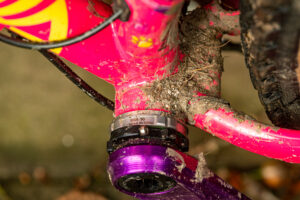In a nutshell, the Trek Cali S lives up to its claim of being the queen of speed.
Trek Cali S (2016) review
Back in 2013, the Trek Cali S won the women-specific category of our Hardtail of the Year test. At that time it was a £700 bike sporting 29in wheels and an air-sprung RockShox fork.
A lot has changed in the three years since. The price of the Cali S has come down by £150, and it’s now sporting 27.5in wheels on the smaller frame sizes.

Obviously we were keen to see if the latest version of the Cali S still had the same ride qualities that won it the top spot before.
Well, the look of the new bike is every bit a stylish as before, with its stealth black finish, green decals and slender aluminium tubing.
Trek has paid a great deal of attention to getting the sizing and fit right too, offering 27.5in wheels on the two smallest frame sizes and 29in wheel on the two larger ones — the idea being that taller riders can still benefit from the extra rolling speed of 29in wheels. At 5ft 4in we chose to test the 15.5in bike, which is the larger of the two 27.5in options.
Interestingly, the latest version of the Cali S is actually 0.8kg lighter than the same size bike we tested three years previously, even though the specification is not as high. Any savings are due to the smaller-diameter 27.5in wheels.
>>> Five tips for setting up your new mountain bike (video)
Suspension
Like the Specialized Jynx Comp, the Trek comes with a custom fork. The RockShox 30 benefits from Trek’s WSD Rider Right coil spring, which sees the Cali S getting 100mm of travel instead of 80mm (although the 13.5in frame has to make do with 80mm) and sporting rebound adjustment and a lock-out feature.

Tektro Auriga disc brakes are assured stoppers
Although an air fork would be preferable from the point of view of both adjustability and weight, we’ll settle for the extra 20mm of travel as this made the ride immediately feel plusher than on the Jynx. We never used the lockout feature but it could come in handy if you commute on the Trek.
Components
The wider handlebar and slender grips on the Cali S immediately give it a sense of purpose and control, which translates to increased rider confidence. The saddle, is also women-specific, offering enough padding without too much squidge.
The Acera/Altus nine-speed drivetrain is the same as the one chosen by Specialized, and again we felt a bit of all-important weight could be saved here by simply going for a double chainset instead of a triple. Sure, the gear range at high speed would be reduced, but given that both bikes are entry-level, we can’t see this being an issue for anything other than commuting.

Frame-routed cables make for a clean outline
Keeping in step with Specialized once again, rolling resistance has been prioritised over outright grip when it comes to putting rubber on the trail. Still, the bigger volume 2.2in Bontrager tyres provide a bigger footprint, so you get more grip and comfort even if the knobs are still quite shallow.
The final piece of the component puzzle is the Tektro’s Auriga disc brakes. Again, these match the Specialized Jynx Comp in name and stopping power, but interestingly, while equally adjustable, Trek has not opted for the WS shorter-reach versions, meaning a couple of extra twists of the Allen key adjusters were required for our little fingers to reach the levers.
Performance
The RockShox 30 fork, which was running well from the get-go, benefited from its extra 20mm of travel and saw us tackling a variety of trails with increasing speed and confidence.

Wide bars and short stem enhance control
The slim grips, wider handlebar and shorter stem added to the sense of control and responsiveness, allowing us to push harder than on the Specialized. Balance and rider position on the Trek was also good, lending itself to technical drop-ins, with the suspension keeping us on line over the roots and catching us in compressions without falling through the travel.
In a nutshell, the Trek Cali S lives up to its claim of being the queen of speed.

Verdict
While the Trek and the Specialized share a good spec and reliable components, the devil really is in the detail. Although, we only rode the 27.5in version of the Cali S — as the 29ers are for riders over 5ft 4in — the slight differences in geometry allied to the 100mm-travel forks up front, and better cockpit, made all the difference. The wider bars, slim grips and fast-rolling but grippy tyres, inspired confidence, particularly when venturing into more technical terrain. When it comes down to it, the Cali’s handling capability and reassuring stability make it a fun bike to ride, with the result being that your skills can develop while you’re having a blast.
















